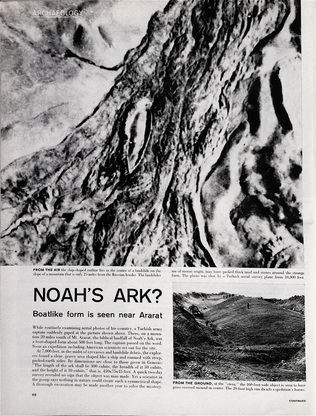 Life Magazine, September 5, 1960, page 112.
Life Magazine, September 5, 1960, page 112. The most widely read article about the discovery of Noah’s ark appeared in Life magazine, September 5, 1960.
Heavy rains and three earthquakes in 1948 exposed a formation that looked remarkably like a boat at the “Durupinar site,” eighteen miles south of Ararat’s summit. The uniqueness of the formation was discovered by Turkish army captain Ilhan Durupinar when he studied photos taken for NATO in 1959. The next year an expedition conducted by the Archeological Research Foundation (ARF) visited the site. After much digging inside the boat-shaped formation, the group concluded, according to their press release, “there were no visible archaeological remains” and this formation “was a freak of nature and not man-made.” In spite of ARF’s conclusion, Life published pictures from the expedition with the headline, “Noah’s Ark? Boatlike form is seen near Ararat.”
The Durupinar site was largely ignored until 1977, when Ron Wyatt, a former nurse anesthetist, adventurer, and self-taught archaeologist from Madison, Tennessee, began promoting it as the site of Noah’s ark. In spite of his efforts to convince others—including astronaut and ark expert James Irwin and John Morris, who later became president of the Institute for Creation Research—that Noah’s ark was at the Durupinar site, he found few to agree with him.
Was Wyatt merely overenthusiastic or a fraud? Probably the latter, although perhaps he believed his own press releases. He made extravagant claims such as saying the Durupinar site contained “trainloads” of gopherwood. In addition to the ark, he claimed to have found the location of Sodom and Gomorrah, the site of the Tower of Babel, and the place where the Israelites crossed the Red Sea. He even claimed to know where the ark of the covenant was (the one Indiana Jones searched for). And yet, scientists, historians, and biblical scholars dismiss his claims. The Garden Tomb Association (Wyatt claims the ark of the covenant is in a chamber on the grounds of the Garden Tomb in Jerusalem.) says it “totally refutes the claim of Mr. Wyatt.”
Heavy rains and three earthquakes in 1948 exposed a formation that looked remarkably like a boat at the “Durupinar site,” eighteen miles south of Ararat’s summit. The uniqueness of the formation was discovered by Turkish army captain Ilhan Durupinar when he studied photos taken for NATO in 1959. The next year an expedition conducted by the Archeological Research Foundation (ARF) visited the site. After much digging inside the boat-shaped formation, the group concluded, according to their press release, “there were no visible archaeological remains” and this formation “was a freak of nature and not man-made.” In spite of ARF’s conclusion, Life published pictures from the expedition with the headline, “Noah’s Ark? Boatlike form is seen near Ararat.”
The Durupinar site was largely ignored until 1977, when Ron Wyatt, a former nurse anesthetist, adventurer, and self-taught archaeologist from Madison, Tennessee, began promoting it as the site of Noah’s ark. In spite of his efforts to convince others—including astronaut and ark expert James Irwin and John Morris, who later became president of the Institute for Creation Research—that Noah’s ark was at the Durupinar site, he found few to agree with him.
Was Wyatt merely overenthusiastic or a fraud? Probably the latter, although perhaps he believed his own press releases. He made extravagant claims such as saying the Durupinar site contained “trainloads” of gopherwood. In addition to the ark, he claimed to have found the location of Sodom and Gomorrah, the site of the Tower of Babel, and the place where the Israelites crossed the Red Sea. He even claimed to know where the ark of the covenant was (the one Indiana Jones searched for). And yet, scientists, historians, and biblical scholars dismiss his claims. The Garden Tomb Association (Wyatt claims the ark of the covenant is in a chamber on the grounds of the Garden Tomb in Jerusalem.) says it “totally refutes the claim of Mr. Wyatt.”
 RSS Feed
RSS Feed